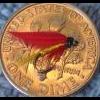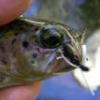-
Content Count
1,338 -
Joined
-
Last visited
Community Reputation
0 NeutralAbout deeky
-
Rank
Advanced Member
- Birthday 11/01/1978
Previous Fields
-
Favorite Species
Crappie
-
Security
22
Contact Methods
-
Website URL
http://
Profile Information
-
Location
Sioux Falls, SD
Recent Profile Visitors
15,684 profile views
-
Been a while since I've been around, but it looks like I've got good timing. I love squirrel tail wings. I tie in the full bundle at the back of the head with a few good wraps. Then I pull a small part of the top fibers straight up and put a good wrap or two against the front of them and over the rest of the fibers. Repeat, repeat, repeat, working your way forward. When you have worked through all of the fibers, use a good, fine scissors and trip the butts tight to the thread and then over-wrap for a clean head. It's perhaps a bit more fiddly than a drop of super glue, but it has always locked things in nicely for me.
-
I've got a Canon along with 17-35 and 70-300 lenses. While the crop sensor does help narrow the field of view (not changing the focal length), my bigger issue is minimum focal distance. While the 17-35 can focus in to a matter of a few inches, it is still too wide of an angle of view and the lens gets in the way of good light (without a lens-mounted ring light). I actually do a fair amount of floral macro-esque work with my 70-300, but with a minimum focus distance of just under 5 feet, it isn't quite tight enough for smaller flies (size 10 and down). I have a 100mm macro lens on my list, but at $500, that's not an immediate purchase at that price. All that said, for what I do, I use a point and shoot in macro mode. Set it on a mini tripod and use the timer to avoid any camera shake due to pushing the shutter button. Shut the camera flash off and pay more attention to getting your lighting right. FYI - my avatar was shot handheld with a p&s in macro mode without paying attention to lighting temp. That's a size 18 without any cropping (vertically). That's my suggestion. But being a camera guy, I can totally understand going out and picking up a new lens as well if you can. Same mentality as the multitude of rods, flies, and everything else we carry around.
-
It's a pretty classic pattern and style. The double hooks are much more predominant in Europe, particularly for sea run trout and salmon. You can easily tie it on a single hook as well.
-
If I recall, the hairs on the feet are hollow to insulate the rabbit from the ground. As much impact on floatability as any oils. Should still float even if the oils are processed out. Otherwise I don't think they would sell as many processed feet as they do.
-
Do a little reading and build yourself a jig to make furled leaders. I haven't had to straighten a single leader since I started using them. Make them whatever weight and length you want. If you need presentation, they are the only leaders you can turn over by hand without the use of a rod.
-
Perhaps a little late, but I use compressed air as well. But I used an empty cd rom container - the flat base with a post in the center that holds a stack of disks. I drilled one hole in the top for the air and I'm in business.
-

Best Big-Fish-Eats-Little-Fish Story
deeky replied to Bryon Anderson's topic in Fly Fishing Gear & Techniques
I had a 5"-6" gill on the line while fishing from a dock. About 10' off the dock I watched as a northern flew up from the bottom and took a swing at my fish. Missing the first time, he circled for a second time before I soaked in what was happening. We fought over the fish for a minute or so before the northern finally let go. But he wasn't done. He came around and grabbed that poor gill a second time. We fought each other for another half a minute or so before my fly finally popped out of the gill's mouth. I got my fly back and the northern got his meal. Worked out well for both of us. -
LOL Actually, that was my thought too. Not too big in diameter, but too long front to back, especially the first one. It's an interesting look and unique use as far as I know. The one question I've had regardless of the use of this style of wing is durability. How do the stems hold up to a few fish?
-
A little finger work should take care of that if not tying it in. If it really is still a problem, make a wrap of thread around just the hair bundle before continuing around the shank. Works well especially when I want a clearly segregated wing as in a traditional Mickey Finn.
-
There is a reason Crappie are also known as Papermouth. For Crappies I prefer Clousers and other flies that swim inverted. The hookset in the top of the mouth has given me the best hold. Black over chartreuse for me.
-

who does deer hair streamers and flys anymore?
deeky replied to djtrout's topic in The Fly Tying Bench
Depends on how you want them to move. Right up front for an up and down jigging motion. The further you move them back the more of a gliding motion you get. Your choice. -

who does deer hair streamers and flys anymore?
deeky replied to djtrout's topic in The Fly Tying Bench
I prefer the first, but because of the relative lengths of the two colors. When the fly flips (is your beadchain enough weight to accomplish that?) I prefer to have my top color be the longest. Not sure if it ultimately matters to fish, but I am somewhere in the middle of the spectrum of tying for fish vs. fishermen. -
I went out and bought 2 or 3 plastic comb binders (clear) at the local office supply store. Cut them into sections of two of the tabs and wrap them around your spools. Keeps everything neat, can still pull material off, and they fit in any spool organizer that your spools will otherwise fit in. I use them on all of my wire, tinsel, floss (have to be a little more careful here), yarn, and whatever else needs taming. Deeky BTW, not my idea. Got it from a friend - the same guy that came up with the D-arm for Peak vices.
-
I fish a lot of small Clousers (8-10) and use your standard Aberdeen style hook for the longer shank. As mentioned, don't tie much longer than the bend to avoid issues with the nippers. They are a wire hook rather than forged so may bend a little easier (nice for bendbacks), but have pulled in 14" carp on them and been fine. Just don't horse it. But also doesn't take as much weight to flip the lighter hook with a straight eye.
-
Sorry to burst your bubbles, but the fly was posted in 2005 and poster hasn't been here since 2006. Hackle fiber tails, tight dubbing up the abdomen, same material in a dubbing loop for the thorax/legs, and some fibers pulled forward and cemented for the wingcase. That's my guess anyway.

